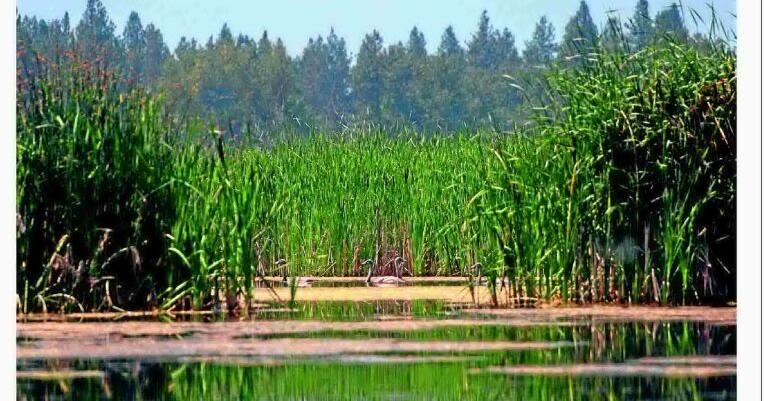LEE METCALF NATIONAL WILDLIFE REFUGE
HAMILTON — Over his 14-year tenure at the Lee Metcalf National Wildlife Refuge, manager Tom Reed has witnessed significant events at the ponds nestled between the Bitterroot and Sapphire Mountain ranges. Recently, he encountered two “firsts” in his career at the refuge within just one month.
In 2019, Reed observed the first documented wild trumpeter swan cygnets in the Bitterroot in recent memory. This rare sighting has recurred annually since then.
In early June of this year, Reed spotted a brood of six cygnets and two swans, and a few weeks later, he saw four cygnets accompanied by two adults on a different pond.
“I’m thrilled that we saw them,” Reed expressed. “Initially, we were concerned and thought we may have lost two cygnets…you would think a large white bird would be visible from afar, but sometimes it’s not.”
People are also reading…
Instead, Reed discovered that the refuge is now home to two separate broods, both of which built nests in the vegetation along different ponds.
In 2020, 242 bird species were documented at the refuge, with 105 nesting on the grounds. Swans, which were nearly extinct in the early 20th century, are gradually increasing in numbers due to restoration efforts initiated decades ago.
Unfortunately, the swans and other waterfowl at the refuge have observed a decrease in water levels in their habitats—a phenomenon Reed had not encountered during his time at Lee Metcalf.
“Those swans will soon be walking on mud here,” Reed commented. “This prolonged heat is unprecedented.”
Since the ponds are artificial, they rely on levees, ditches, and water control structures to sustain waterfowl. The refuge was established in 1964 and designated ponds ranging from eight acres to over 200.
Last Thursday, water levels began dropping significantly. The supply ditch providing water to the 14 ponds completely dried up within a week, but over the weekend, the water flow partially resumed.
Fortunately, this issue is expected to be temporary. The Supply Ditch Association, the provider, shut off the water to the supply ditch for maintenance, and it will take a few weeks for the ponds’ water levels to normalize.
The dwindling water levels have repercussions on the refuge, particularly on the young wildlife. Unable to fly yet, the drying ponds make it easier for predators to prey on them. Stagnant water can lead to rapid growth of aquatic vegetation, which could be detrimental to wildlife and plants.
“We have a variety of species out there—not just swans,” Reed mentioned. “It’s a challenging time of year for the area to become dry.”
Moreover, the high temperatures and recent heatwave exacerbate the situation, prompting warnings and temporary restrictions on nearby rivers. The low snow season in Montana has also contributed to the water supply issues, according to the Natural Resource Conservation Service (NRCS) Montana Water Supply Outlook Report.
Across the Bitterroot region, water users are bracing for the impact of this year’s drought. JR Iman, the Bitterroot River Commissioner, forecasted that the water levels in the Painted Rocks Dam could run dry within the next 35 days.
“During tough times, everyone must cooperate,” Iman emphasized. “The drought doesn’t mean a lack of water. It’s about not having enough water when you need it.”
Each year, water is stored in the reservoir, which overflows and prepares for the upcoming season. As summer progresses, the reservoir’s water levels decrease with reduced inflow from the streams, necessitating intensive water management.
This year, the area received only about 60% of its typical precipitation, marking the third consecutive year of below-average rainfall, according to Iman.
The dam ceased overflowing recently, signifying that the remaining water is shared between the Montana Department of Fish, Wildlife and Parks (FWP) and the Painted Rocks Water Users Association (PRWUA) for agriculture and river flow maintenance.
During water scarcity, Montana water law dictates priorities based on seniority, meaning those who first utilized water have precedence. If senior rights holders don’t receive enough water, they can prevent junior rights holders from using it until their needs are met.
“Water rights are not based on necessity,” Iman explained. “Supply Ditch holds significant water rights from the river, but everyone faces shortages when resources are limited.”
The refuge hasn’t felt the full impact of water scarcity yet, but the situation remains uncertain as water levels continue to decline.
As of Friday, the ponds were still shallow, but with ongoing high temperatures and reduced inflow, the water depth will gradually decrease before returning to normal levels.
Currently, the wildlife and new swans at the refuge are faring well. It may take until fall for the cygnets to take flight, closely guarded by their vigilant parents until they mature.





